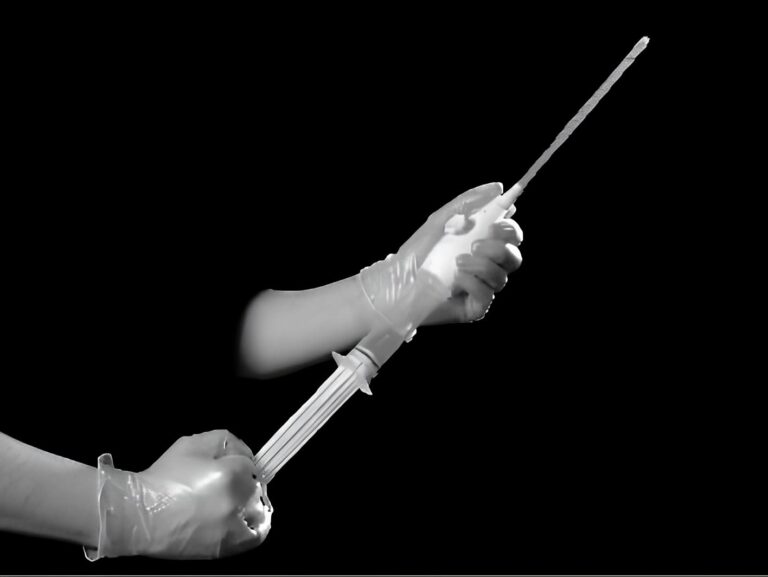Editor’s note: Population control is literally and figuratively dehumanizing. In India, thousands of women are being herded into mass sterilization camps, where surgeons mutilate their reproductive organs in assembly line-fashion under unsanitary conditions, sometimes using bicycle pumps as medical instruments, and where mortality rates reach as high as 500 per 100,000 sterilizations. This article, the first of two parts, focuses on one such sterilization camp in Kerala, India.
Women started arriving at the camp by 9 a.m…, many carrying infants and all accompanied by their husbands or other women relatives. In some cases, the junior public health nurses (JPHNs), who were responsible for ‘motivating’ these clients to accept sterilization, also accompanied them.1
As only two vehicles were available to the camp organizers, most of the women and their companions had to get to the site on their own. Of the 49 women scheduled for surgery that day, 48 actually were sterilized. Most of the women were in their early 20s; a few were in their 30s. On the average they had two children, although one or two of them had as many as four.2
The sterilization camp was conducted in October 1994 at a rural hospital in the Palakkad district of Kerala, India. The operations took place in a building within the hospital compound but, since the facility lacked the equipment and experienced staff to perform laparoscopic sterilizations, a team from another part of the district was brought in to perform the operations.
The premises consisted of a rectangular hall (22 feet x 10 feet) with an attached bathroom. It was here that the women gathered for pre-surgical examinations. It also doubled as the post-operative ward. The hall contained nine cots, each equipped with a mattress, bedspread and pillow. A bed at the far end of the room was used as an examination table by the doctor who performed the pre-operative examinations. There were two ceiling fans, one at each end of the room, to cool the hall.
The operating theatre was located in a room at the other end of the same building, linked by a 30-foot-long corridor to the pro- and post- operative area. The furniture in this room consisted of three wooden benches, four small tables, one washing basin, one ceiling fan, three old pillows and one steel container for syringes. There was a fluorescent lamp and several windows, some of which had broken catches. The operating space and the furniture had been washed with disinfectant early that morning.
Client ‘registration’
When it was time to register, the women queued up in front of a female doctor who sat on a chair next to a bed at one end of the hall. The doctor took the woman’s blood pressure “if she thought it was necessary, ” checked the pulse and asked about any previous health problems.
Written consent was obtained at this time and the women were seen affixing their signatures to some printed forms. However, very little about the sterilization procedure was explained to them, nor were any alternative options offered.
A few of the women were given pelvic examinations. When the doctor was asked why that examination was limited to those women, the reply was that a pelvic examination was only warranted in “suspicious” cases — i.e. when she felt that the client exhibited signs of reproductive tract problems. For a pelvic examination, the women were led to a roped-off area in the hall; there was absolutely no privacy.
At one point, there were 87 people in the room, including JPHNs, junior health inspectors (JHIs), health supervisors (HSs), lady health supervisors (LHSs), nurses and doctors — all jostling for space with the women, their female relatives and their infant children. The men folk were not allowed into this room; they lounged about outside the premises.
As part of the registration procedure, urine tests for sugar and albumen were performed. They were conducted in a small room, which had a toilet, and opened onto the corridor that connected the pre-operative hall to the operating room. The women, with a small bottle in hand, lined up at the door to the toilet, where they collected their urine samples. Each woman brought her specimen to one of the JPHNs and was directed to pour it into a test tube, which was held out to her. The woman was then told to rinse out the collection bottle in the wash basin and hand it to the next woman to use.
The registration process was completed by 11 a.m. Since there was very little seating available, most of the women and their attendants had to stand while waiting for the arrival of the surgeon. Some of the mothers breast-fed their babies while squatting on the ground outside the building. As the delay lengthened, many of the women and their family members became restless and the JPHNs and JHIs had to pacify their clients and request that they remain until the surgeon arrived.
The 48 women, clutching their registration papers, again queued up, this time at the entrance to the operating room. The staff and other attendants ate lunch but the women undergoing surgery could not. The surgeon finally arrived with his team at about l p.m. and set up his equipment; the staff got any straggling clients to join the line and operations were started at 1:15 p.m.
The surgical disassembly line
In the makeshift operating theatre, the three rectangular benches had been raised at an angle, using the square tables to balance them. The women were instructed to lie on these with their heads at the lower end. Each of the three benches had a pillow placed in the middle and a bed sheet draped over it. Another table served as an instrument trolley.
Movement into the operating space was restricted once the surgeries began. Those involved in performing the operations did not come out at all, but passed on instructions about any requirements to an assistant waiting just outside the door to the room, which was kept shut.
Each of the women in her turn had to climb up on one of the three benches and lie down, assisted by one or two female staff members. First her abdomen was prepared for surgery by swabbing and injection of a local anesthetic. Then the abdomen was inilated with gas. Two tubes were inserted into incisions in the abdomen: one was for inserting the light source and the other was for inserting the instrument for tying the Fallopian tubes.
The third stage was the sterilization itself. When the first woman was at the second stage of the procedure, the first stage was started with a second woman. When the first woman reached the third stage, the first stage was started with the third woman. When the first woman lifted herself off the angled bench and walked out of the room on hr own, another took her place and so the cycle commenced again.
On average, it took just four to five minutes for the completion of this three-stage procedure. Since three women were going through the different stages simultaneously, the total time taken for all 48 women was just 128 minutes — i.e., two hours and eight minutes. The surgeon thus spent an average of only two minutes and 40 seconds per sterilization.
The linen on the three makeshift operating beds was never changed during the course of the day’s surgeries. Moreover, the surgeon never once changed his gloves during the course of the 48 surgical procedures he performed. Unfortunately, this disregard for aseptic conditions is quite common in the Indian sterilization camps and has been reported often through the years.
Since the observers who reported on this particular sterilization camp were unable to see at close range what was happening within the operating room, there was no way of telling whether instruments and syringes had been properly sterilized. With the syringes and other instruments being boiled on a stove throughout the surgeries, at least an attempt at sterilization was made. It was obvious, however, that the guidelines for disinfection of a laparoscope could not possibly have been met.
According to Indian health regulations, laparoscopes must be washed after each operation, dried and immersed in a disinfectant solution (usually Cidex) for at least 30 minutes, and then washed with sterile water before being used on the next patient.3 A thoroughly inadequate “40—60 second soak” in some solution was apparently all that was done to sterilize the laparoscope(s).
Furthermore, according to the guidelines, the maximum number of laparoscopic sterilizations that can be carried out by a single team using two laparoscopes in a period of two hours is six, or a maximum of 24 sterilizations in an eight hour working day.4
Post-operative carelessness
All of the women who were sterilized had to walk by themselves back to the hall, which now served as the post-operative ward. They lay on the nine available cots, usually two per cot. The rest were accommodated on bed sheets spread out on the unswept floor, five women per sheet.
As each woman lay down on a cot or a sheet, a nurse sprayed the area around the abdominal incisions with an antiseptic and dressed the small wounds. The women were provided with an antibiotic and a pain killer and were instructed to contact the local JPHN in case of any problems. No doctor examined or counseled the women after surgery.
As the number of women who had been operated on increased, the available space in the hall begin to shrink. The last of the women had to lie on a bed sheet at the entrance to the bathroom, which was being used extensively by the women and their attendants. Extensive seepage from this overused bathroom barely missed the feet of the women lying on the bed sheet near it. The odor emanating from the bathroom was “quite overpowering.”
Safe drinking water was not available at all, although there was a plentiful supply from a tap in the toilet room next to the operating theatre. The women and their attendants were expected to make their own water arrangements. Even this most basic need of the women was clearly not a priority.
While the operations were proceeding, the District Medical Officer (DMO) came to inspect the hospital. He condemned certain items of equipment which were being used. The JPHNs and JHIs at the camp took the opportunity to inform the DMO about the problem of non-payment of incentive money to their clients during the previous months. (An incentive payment of 145 Rs is paid to sterilization acceptors.) The JPHNs and JHIs knew that the people they served were upset that the incentive payments had not been immediately disbursed, and they were worried that as word spread in the community they would find it difficult to “motivate” future clients.
The surgeon and his team left the camp by 3:45 p.m., shortly after completion of the operations. Most of the JPHNs and JHIs also left the camp immediately, leaving the women and their attendants to fend for themselves. By 4:30 p.m., many of the women began leaving the premises, although they could barely walk; none of them were permitted to stay in the building beyond 5 p.m.
Provider’s problems
For the hospital nursing staff who had been assigned to supervise the camp, the job meant extra work. They had to borrow the furniture required for the makeshift operating tables and had to procure the stoves and utensils required from other hospital wards. Since none of the hospital workers was willing to transport the furniture, laborers from outside had to be hired.
In one case an argument broke out between a JHI and JPHN over to whom a particular client belonged. Although initially recruited by the JHI, the woman had moved and came to the camp under the care of the JPHN who covered her new place of residence. As every worker had to meet a fixed target of clients for sterilization, the need to fulfill these quotas resulted in frequent wrangling between the health workers.
One candid report from four Indian surgeons who performed female sterilizations detailed the travel, lodging, and operating problems they faced in servicing distant rural camps.5 Often only a “small vehicle like [a] jeep was made available [in which] six to seven persons had to be accommodated …in addition to linen, instruments…and operating tables.”
Not only was the vehicle small, but it was usually “unfit to run over long distances and invariably would tail on the way,” resulting in a wait for hours until another vehicle was available for rescue and repairs. And then, after a long and tedious journey, the doctors often found that “arrangements for comfortable lodging and boarding were not made” and they had to “pass uncomfortable nights or…run to local doctors’ residences for night rest.” Boarding arrangements were often “meager instead of full meals.”
Dark and dirty business
As for the operating theatre, sometimes the “flooring was dusty and unclean [and] the lighting…was very poor .…” At many places the artificial light which was available was “insufficient and uncertain because of drop[s] in voltage or power out[ages].” Nonetheless, at some of the camps the surgeons operated “round the clock through day and night with very scanty light — only one torch for two tables or so.”
Usually there was a shortage of linen required for the numbers of women to be operated on, and the sterilization of instruments and linen was inadequate. Often the local nursing staff who assisted the operations seemed to be “assisting for the first time,” which in fact was the case, as subsequent inquiry discovered. Moreover, the pre-operative preparation of the patients was so unsatisfactory that some of the women had apparently eaten recently and/or had not properly evacuated themselves, resulting in some even vomiting on the operating table, causing a postponement in their sterilization.
Although the team of observers found the Kerala camp conditions “appalling,” they were ‘“not as bad as elsewhere in the country.”
In many instances the sterilization camps were conducted in makeshift locations without even a thought to aseptic conditions. School classrooms have been used without any effort to disinfect them, and “rusted, broken down tables draped with soiled rubber sheets have been used as operating tables.” Surgeries have been performed with “just one bucket of water for the surgeons to ‘disinfect’ their hands before operating.” The same syringe has been used on all the clients.
Endnotes
1 M. Ramanathan, et al, “Quality of care in Laparoscopic Sterilisation: Camps: Observations from Kerala, India,” Reproductive Health Matters, No. 6, November 1995, 84- 93, at 85. The camp was conducted at a rural hospital in the Palakkad district in October 1994. Except as otherwise noted, all information and quotations in this report were taken from the article herein cited.
2 Information based on interviews with 19 of the 48 women sterilized that day. Since the women who were interviewed were not randomly selected, the characteristics of the majority may have differed somewhat from those 19.
3 Government of India, health regulations, as cited by Ramanathan, et al, “Quality of care,” note 1, above.
4 Ibid.
5 Limaye, et al., “review of tubectomy camps in rural area,” Journal of Obstetrics and Gynaecology of India, August 1982. V. 32, No. 4, 552-4.










